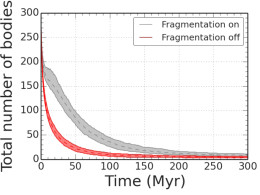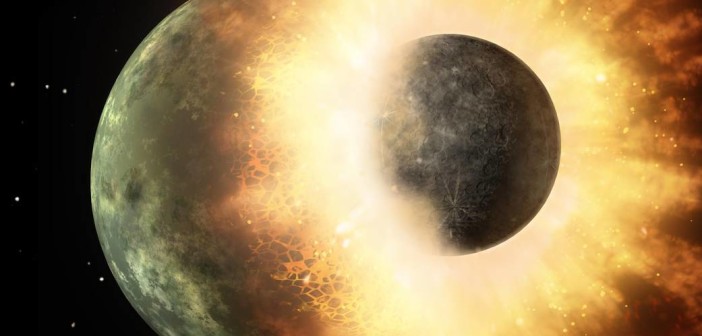Earth has experienced a large number of impacts, from the cratering events that may have caused mass extinctions to the enormous impact believed to have formed the Moon. A new study examines whether our planet’s impact history is typical for Earth-like worlds.
N-Body Challenges

Timeline placing the authors’ simulations in context of the history of our solar system (click for a closer look). [Quintana et al. 2016]
There are two major challenges when simulating this N-body planet formation. The first is fragmentation: since computational time scales as N^2, simulating lots of bodies that split into many more bodies is very computationally intensive. For this reason, fragmentation is usually ignored; simulations instead assume perfect accretion during collisions.

Total number of bodies remaining within the authors’ simulations over time, with fragmentation included (grey) and ignored (red). Both simulations result in the same final number of bodies, but the ones that include fragmentation take more time to reach that final number. [Quintana et al. 2016]
Adding Fragmentation
A team of scientists led by Elisa Quintana (NASA NPP Senior Fellow at the Ames Research Center) has recently pushed at these challenges by modeling inner-planet formation using a code that does include fragmentation. The team ran 140 simulations with and 140 without the effects of fragmentation — using similar initial conditions — to understand how including fragmentation affects the outcome.
Quintana and collaborators then used the fragmentation-inclusive simulations to examine the collisional histories of Earth-like planets that form. Their goal is to understand if our solar system’s formation and evolution is typical or unique.
How Common Are Giant Impacts?

Histogram of the total number of giant impacts received by the 164 Earth-like worlds produced in the authors’ fragmentation-inclusive simulations. [Quintana et al. 2016]
Examining the 164 Earth-analogs produced in the fragmentation-inclusive simulations, Quintana and collaborators find that impacts large enough to completely strip a planet’s atmosphere are rare; fewer than 1% of the Earth-like worlds experienced this.
But giant impacts that are able to strip ~50% of an Earth-analog’s atmosphere — roughly the energy of the giant impact thought to have formed our Moon — are more common. Almost all of the authors’ Earth-analogs experienced at least 1 giant impact of this size in the 2-Gyr simulation, and the average Earth-like world experienced ~3 such impacts.
These results suggest that our planet’s impact history — with the Moon-forming impact likely being the last giant impact Earth experienced — is fairly typical for Earth-like worlds. The outcomes also indicate that smaller impacts that are still potentially life-threatening are much more common than bulk atmospheric removal. Higher-resolution simulations could be used to examine such smaller impacts.
Citation
Elisa V. Quintana et al 2016 ApJ 821 126. doi:10.3847/0004-637X/821/2/126

3 Comments
Pingback: giant impacts, stripping atmospheres making Moons
Pingback: Giant impacts typical for Earth-like worlds – Diashmond
Pingback: Giant Impacts on Earth-Like Worlds - Blog - Asteroid Day